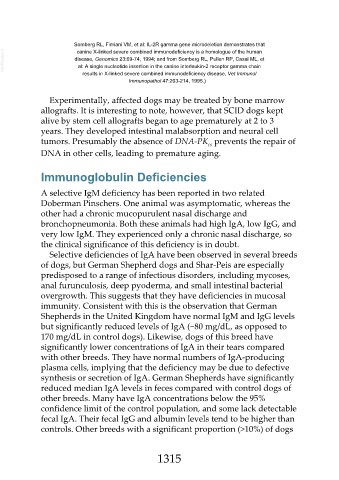Page 1315 - Veterinary Immunology, 10th Edition
P. 1315
Somberg RL, Fimiani VM, et al: IL-2R gamma gene microdeletion demonstrates that
VetBooks.ir disease, Genomics 23:69-74, 1994; and from Somberg RL, Pullen RP, Casal ML, et
canine X-linked severe combined immunodeficiency is a homologue of the human
al: A single nucleotide insertion in the canine interleukin-2 receptor gamma chain
results in X-linked severe combined immunodeficiency disease, Vet Immunol
Immunopathol 47:203-214, 1995.)
Experimentally, affected dogs may be treated by bone marrow
allografts. It is interesting to note, however, that SCID dogs kept
alive by stem cell allografts began to age prematurely at 2 to 3
years. They developed intestinal malabsorption and neural cell
tumors. Presumably the absence of DNA-PK prevents the repair of
cs
DNA in other cells, leading to premature aging.
Immunoglobulin Deficiencies
A selective IgM deficiency has been reported in two related
Doberman Pinschers. One animal was asymptomatic, whereas the
other had a chronic mucopurulent nasal discharge and
bronchopneumonia. Both these animals had high IgA, low IgG, and
very low IgM. They experienced only a chronic nasal discharge, so
the clinical significance of this deficiency is in doubt.
Selective deficiencies of IgA have been observed in several breeds
of dogs, but German Shepherd dogs and Shar-Peis are especially
predisposed to a range of infectious disorders, including mycoses,
anal furunculosis, deep pyoderma, and small intestinal bacterial
overgrowth. This suggests that they have deficiencies in mucosal
immunity. Consistent with this is the observation that German
Shepherds in the United Kingdom have normal IgM and IgG levels
but significantly reduced levels of IgA (~80 mg/dL, as opposed to
170 mg/dL in control dogs). Likewise, dogs of this breed have
significantly lower concentrations of IgA in their tears compared
with other breeds. They have normal numbers of IgA-producing
plasma cells, implying that the deficiency may be due to defective
synthesis or secretion of IgA. German Shepherds have significantly
reduced median IgA levels in feces compared with control dogs of
other breeds. Many have IgA concentrations below the 95%
confidence limit of the control population, and some lack detectable
fecal IgA. Their fecal IgG and albumin levels tend to be higher than
controls. Other breeds with a significant proportion (>10%) of dogs
1315

